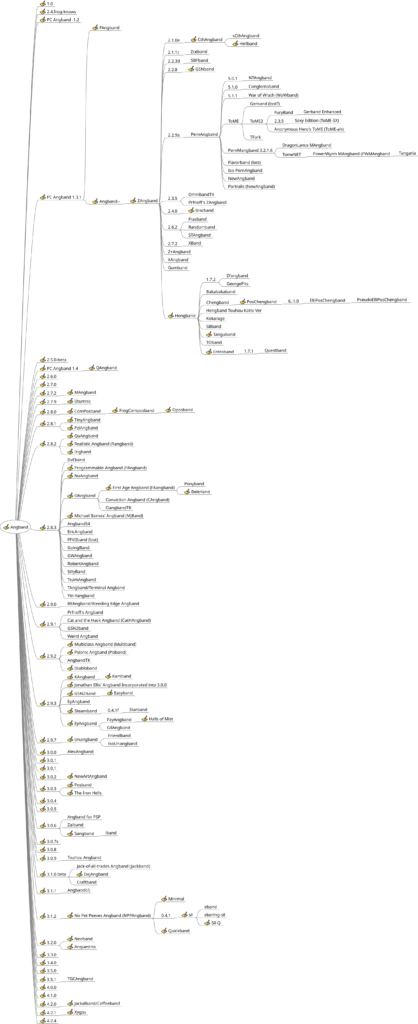
‘@Play‘ is a frequently-appearing column which discusses the history, present, and future of the roguelike dungeon exploring genre.
It’s finally time. Time to reveal the maelstrom of roguelike games which has, as its center, the game of Angband.
You might be interested in our other recent columns on Angband: Re-introduction, Getting Started, and Version History.
Here is a chart of the 100-plus variants of Angband (homepage) that we know of. RogueBasin and the variants table at Tangaria were both major sources for this. You might have to right-click it and download to view it without blurring. Here’s a direct download of the PNG.

The degree to which these games have been changed from the original varies tremendously, from slightly hacks to repurposings to entire other games. In ToME, Angband was used as a base that would be completely rewritten, twice, and turned into something completely separate. Many of these games could have whole articles written about them. I’ve written at least one so far, on Zangband.
Looking through the chart, one can find two great jumping-off points from Angband’s source tree. One is PC Angband 1.3.1, largely because of being the original base of Zangband, and the other is Angband 2.8.3, which was the site of legendary maintainer Ben Harrison’s great cleanup of the code, which made it much easier to create variants than it had been.
Looking at the list, one might get the impression that this list also serves as a timeline, but that would be in error. Some variants would be updated over time, bringing in features from later in Angband’s development, and this chart doesn’t reflect that, and sometimes a game wouldn’t branch off from the newest version of the code. Please keep this in mind when looking through it.
A few interesting finds from the list:
Steamband is a complete reskinning in a kind of Jules Verne pulp steampunk style. It is what we might call a literary game, taking direct inspiration from a particular corpus of stories in the same way as Call of Cthulhu or Gygax era Dungeons & Dragons. In it, you start in a town in the center of the Earth, and try to ascend to the surface. It has some interesting ideas around the theme, but I cannot recommend it wholeheartedly because of its “race” system, which is easy to perceive as actually racist. I think its intent was to present the racial attitudes of the fiction works from which it was derived, which were really terrible, but it comes across, not to mince words, as gross these days.
There are two My Little Pony variants, based off of the “G4” version of the franchise that became meme popular for about 45 minutes of web time. Ponyband, a.k.a. My Little Angband: Dungeons Are Magic, derives from the popular 2.8.3 branch; Anquestria got its basis from the later 3.2.0.
ToME, a fairly popular variant, has the distinction of not only having a living homepage, but is also available on Steam and GoG. It has a free version, but other features are available to paying players. It’s a game that’s changed a great deal over time, starting out as Tales of Middle Earth. Now, little of its Tolkien basis remains, and its name has been retconned into “Tales of Maj’Eyal,” because you gotta have an apostrophe. Its page vaguely gives it an air of being an MMORPG, but I think it’s still a strictly single-player game. It is a game that, judging from comments, there is a great deal to get stuck into, but to my eyes it has a lost the simplicity of its origin, and it’s not an easy game to pick up. It is still under development though, and that is beyond laudatory for a game of its age and lineage.
Ironband is a challenge variant, intended to make the original game even harder. An “ironman” mode, preventing the player from going upstairs, forcing them to descend ever deeper, is part of the base game now. Ironband dates back to 2012, which may be before this mode was added, although I cannot date its inclusion conclusively right now. But whether is or not, by devoting itself to this mode of play, it is free to be completely redesigned around it. So, Ironband has streamlines the game in its service, removing races and classes, and giving the player all of their options at once. After the start of the game, there are no shops at all; everything the player gains after that point must come from the dungeon floor. Because all characters can use all things, there’s much fewer completely useless items. The “stat gain floor” phenomenon, where you have to grind on certain floors to get necessary potions to improve your attributes or risk almost certain death, has also been alleviated. Because dungeon progress is one way, it refreshes the skill points that your abilities require upon entering a new level, which is an interesting play decision: if you run out of SP, you can get them back by advancing a floor, but at the cost of increasing the game’s difficulty, possibly earlier than you’d want.
